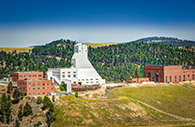University researchers contribute to DUNE, the world's biggest neutrino experiment
Tuesday, July 25, 2017
This animation shows how the international Deep Underground Neutrino Experiment will help scientists understand how the universe works. Video courtesy of Fermilab.
MANHATTAN — A large international team of researchers — including Kansas State University scientists — is turning to tiny particles to address big questions about dark matter, black holes and the origins of the universe.
The Deep Underground Neutrino Experiment, or DUNE, aims to answer these questions by detecting and studying neutrinos. Friday, July 21, marked the construction groundbreaking of the Long-Baseline Neutrino Facility, which will house DUNE.
The neutrino facility will send particles 800 miles through the earth from Chicago to a mile-deep detector in South Dakota. Kansas State University researchers are involved in the organization of the project and are developing the experiment's high-voltage system.
"On the national level, DUNE is the highest-priority project in the U.S. Department of Energy's Office of High Energy Physics," said Tim Bolton, professor of physics. "It's important for us to engage with the international science community on groundbreaking projects like this."
Bolton is serving on the leadership team that is organizing the experiment and Glenn Horton-Smith, professor of physics, is helping to develop the experiment's high-voltage system. Both Bolton and Horton-Smith are experts in experimental high energy and particle physics and have been involved since the early planning phases of DUNE. Other university researchers involved include Ajib Paudel, doctoral student in physics, Nepal; Heng-ye Liao, postdoctoral fellow in physics; and the Electronics Design Laboratory, led by engineers Tim Sobering and Russell Taylor.
"This project lets us chart unexplored areas," Horton-Smith said. "We can gain knowledge in fundamental physics as well as the early universe."
DUNE is a large international collaboration of about 1,000 scientists and engineers from 30 countries. DUNE's Long-Baseline Neutrino Facility involves two U.S. facilities: The U.S. Department of Energy’s Fermi National Accelerator Laboratory in Illinois will send a beam of neutrinos 800 miles through the earth to the Sanford Underground Research Facility in South Dakota.
During the 10-year construction process, workers will excavate more than 800,000 tons of rock to create huge underground caverns for enormous particle detectors, which will enable researchers to study and understand neutrinos. Neutrinos are the most abundant matter particles in the universe, yet very little is known about their role in the evolution of the universe. Scientists will study the interactions neutrinos make with argon atoms to learn more about these elusive yet abundant particles.
Kansas State University researchers are developing the high-voltage system for the detector at Sanford Underground Research Facility in South Dakota. The four-story detector will be nearly a mile underground and filled with liquid argon. The university researchers have designed a system that safely manages and distributes voltages of more than 100,000 volts and creates an equal electric field between the two large electrodes that make up the detector.
The university researchers also have been involved in the construction of the high-voltage system, which has to be folded to fit into a small space and then unfolded while still maintaining electrical connections.
"It's like building a ship in a bottle," Horton-Smith said. "It has involved a lot of engineering and physics to make sure that this design maintains a reliable connection during the construction process."
To prepare for DUNE, the researchers are participating in a smaller prototype test currently being assembled at CERN, the European Organization for Nuclear Research, near Geneva. The university physicists have been involved in the design, testing, delivery and production of the high-voltage system for the prototype. The team will analyze prototype data and make design improvements before installing the real high-voltage system at the Long-Baseline Neutrino Facility during the later construction stages.
When the neutrino facility is up and running, Bolton, Horton-Smith and the other university researchers hope that scientists learn more about the relationship between matter and antimatter. While everything is made of matter, its opposite partner — antimatter — is very rare and can only be created by high-energy physics. The DUNE research may help address a major physics puzzle: Why is the universe made of all matter when it could be an equal mixture of matter and antimatter?
"It's a huge puzzle in understanding how the rules of physics apply to the very large scale," Bolton said. "This project is a long-term investment, but there are many benefits as you learn more about the fundamental ways that nature works."
The project is funded by the U.S. Department of Energy's Office of Science in conjunction with CERN, the European laboratory for high energy physics, and international partners from 30 countries.

